Algorand and The Blockchain Trilemma — Crypto Academy || S5W4 — Homework post for nane15
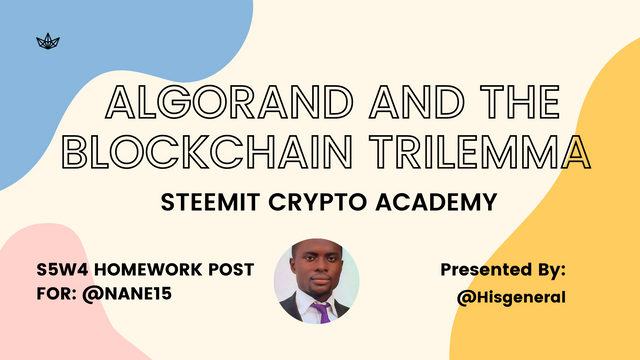
Thanks to you professor @nane15 for bringing such interesting and mind-blowing topic to the class and for your explicit lecture on it. Indeed, it is an eye opener to another kinda hybrid blockchain anyway, I welcome everyone to this discussion.

1. What is Algorand blockchain?

Algorand blockchain is a cryptocurrency blockchain platform that strives to be scalable, secure, and decentralized. Smart contract functionality is one component that is very much supported by the Algorand platform and also the consensus algorithm of the Algorand platform is based on the principles of Pure Proof-of-Stake (PPoS) as well as a Byzantine Agreement protocol furthermore, Ago is the native cryptocurrency of Algorand blockchain.
The open-source Algorand MainNet was the initial use of Algorand's blockchain. The Algorand Foundation supervises the Algorand blockchain as well as the world's initial pure proof-of-stake protocol and is available for any organization or individual to act upon.
The world's initial foundational blockchain of pure proof-of-stake was developed by Algorand aimed at future finance. The technology of Algorand further away than the basic prerequisite of an accessible, public network facilitates a cluster of high executing Layer-1 blockchains that offer scalability, co-chains, security, built-in seclusion, advanced smart contract, and complete transaction finality that are crucial in the future finance world.
Algorand blockchain is an open-source blockchain project which is compatible with the invention or production of DeFi and DApps on its scalable, secure and productive blockchain platform making the Algorand blockchain a high-fulfilling and defensible blockchain and its layer-1 smart contract is one-of-a-kind as it can satisfy the desires of developers as well as numerous companies. Nevertheless, the Algorand blockchain intends to heighten its transaction to as far as 46,000 transactions per second to make available the most inexpensive transaction fees on an extremely defensible network.
Furthermore, the Algorand blockchain is constructed on the basis of a permissionless blockchain protocol that has the capacity of completing transactions without any form of skepticism.

2. What is PPoS?

The Pure Proof-of-Stake (PPoS) is exclusive to Algorand blockchain and a consensus mechanism that guarantees taking part extensively in a completely decentralized network in addition to blockchain protection and reasonable transfer rates. The Pure Proof-of-Stake is distinguished from the Proof-of-Stake because the consistency of stake (the amount of $ALGO own) is not the only criteria for selecting validators to take part but it also allows for random nomination of validators irrespective of the number of coins in their possession and the automatic nomination of validators is based on VRF (Verifiable Random Function).
The influence of every user on the choice of a new block is symmetrical to its number of tokens in the system although users or validators are selected at random and confidentially to propose blocks as well as vote on block tenders. However, every online user stands a chance of being assigned to propose as well as vote meanwhile, the odds that a user will be nominated, as well as the significance of its votes and proposed is dependent on its stake.
The security of the entire economy PPoS approach is bound to the integrity of the majority of the economy instead of a little fraction of the economy. This means that the system is protected when a greater part of the token is in reliable hands and consequently, it is difficult if not impossible for the entire system to be wrecked by those who possess a little amount of the token, and on the other hand, it would also be unreasonable for those that have a reasonable amount of the token to act up reason being that the purchasing power of the currency would decline and eventually result in depreciation of their assets.

3. Explain the advantages and disadvantages of PPoS.

Advantages of PPoS
The Algorand transfer existing like a large payment network, blocks on its consensus mechanism are completed within seconds making it the leading blockchain to guarantee instantaneous transaction completion without the danger of a hard fork.
The high speed of the PPoS is as a result of the certainty that in the circumstances that a vicious actions are noticed or false block is proposed by a node, those who owns the troublesome stake are not subjected to penalty. This is to prevent or evade the network's activity interruption once there is a notification of such a drive and consequently, together express contempt for a negative outcome.
The PPoS involves Verifiable Random Function (VRF) which does not need huge energy amount nor need intricate hardware to be performed. That is to say that a Pure Proof-of-Stake validator isn't required to infuse huge resources before taking part in the network.
Every user in the blockchain can at some point be nominated to take part in the validation and this guarantees increased decentralization level as well as security.
There is high discouragement of attacks or activities of vicious entities and persons as only the proposed ones has access to check if they have been nominated.
It is after a user had taken part in the consensus protocol than an opponent can learn who had weight in the creation of the next block and this hinders attack on the network.
Disadvantages of PPoS
Besides the exclusive control a huge number of staked tokens can generate, which is deciphered by PPoS, the consensus mechanism has quite similar disadvantages as the PoS
The rewards from the staking are not relatively favourable, with exception of connection to huge amount of staked tokens
The amount of tokens staked by node who proposed an erroneous block is not curtailed to dissuade future participation.
Rather than the above stated, the system revert to recovery mode and the process goes on. Although this guarantees heightened speed, it is also censured by the community for the failure of penalizing vicious participators.

4. Do you think Algorand really solved the blockchain trilemma? Explain your answer.

PPoS is an advancement on the PoS and as we well know, the initial consensus algorithm was the PoW (Proof-of-Work) inaugurated in 2009 but has appeared to be anachronistic with regards to the current evolution of consensus mechanisms for blockchains.
The PoW requires a whole lot of energy to have mining computers unravel difficult math-related puzzles and a miner is rewarded with Bitcoin for solving these puzzles. This however leads to an energy-intensive centralized system in which the most powerful of the computers wins.
Proof-of-Stake (PoS) and the other hand was able to solve the computational power struggle as it assigned validating power to the percentage of token or coins a validator has thereby obliterating the need to make use of energy in solving a complex puzzle as validating power is exclusive to the proportion of transaction determined by the percentage of coins in the user's possession. In addition, the PoS fights down the probability of 51% attack as it permits validators to be rewarded with solely a specific percentage of the fee.
Nevertheless, the PoS is affected by its own inherent issues which led to the development of Delegated Proof of Stake (DPoS) and Bonded Proof of Stake (BPoS) which are two major models of the PoS.
In contrast to the Proof-of-Work protocol, the Delegated Proof-of-Stake protocol is apt to efficiently deal with transactions because of the limited number of block producers. The Delegated Proof-of-Stake protocol encounters the problems of insecurity and centralization despite it being more effective and scalable when described in relation to Proof-of-Work.
The Bonded-Proof-of-Stake on the other hand is a protocol in which users earmark a fraction of their stake to be able to impact the generation block. These stakes are frozen in the form of a security deposit for a specific time period and the users are in exchange are offered an opportunity to choose the next block proportional to their stakes. Voting power in this protocol is dependent on the stake a user is ready to freeze and as soon as the stake is frozen, it cannot be withdrawn or removed until the time period elapses hence if a user is found to be malicious or dishonest, the user's deposit, as well as the benefit of taking part in the process of consensus, is lost. The disadvantage of the Bonded Proof-of-Stake protocol is the diminution in the user's proficiency to spend their token or stake during the same time they are taking part in the consensus protocol.
**Pure Proof-of-Stake (PPoS) solved the challenges encountered by PoW, PoS as well as DPoS and BPoS.
With the PPoS, the selection of users who vote on block proposals and propose blocks are confidential and unsystematic also the influence of a user on the vote commensurates with the stake of those users in the system. The security of the entire system is clamped to the truthfulness of the majority.
No small group of users is set in charge of the generation of blocks and no user is required to delegate voting and this protects every user from attack. Users are not also required by the PPoS to freeze a fraction of their stake to take part in the consensus protocol also the ability of users to spend their stake is not diminished whilst taking part in the consensus protocol.
Since the selection of users is confidential and unsystematic, unethical users won't be aware of the user who will generate the next block until after the completion of the consensus, this impedes attacks from vicious users. Furthermore, it is extremely difficult if not impossible for the whole economy or system to be harmed by a little stake of users, and this guarantees complete decentralization.
With the above said, I will say that the PPoS solved the blockchain trilemma.

5. Do you think PPoS is better than PoW? Explain your answer.

The PoW as we know is an approach where users compete to ti provide solutions to a difficult mathematical puzzle which is also known as mining and the first user to provide the accurate solution is given the right to add the next block to the blockchain and also is given a reward for that. PoW is capital-intensive, inefficient, and often demands sophisticated hardware as well as consumes a whopping amount of energy hence, profit-making is exclusive to those professional miners that have enough capital to purchase the kind of sophisticated mining pieces of equipment.
Only such a class of people can take part in and benefit from the generation of blocks, this implies that the efforts of other users are wasted since the puzzle is solved and a new block is generated by only one user. In the PPoS protocol on the other hand solving a puzzle to qualify for proposing or validating blocks is not a prerequisite hence any that has a stake and is online is qualified to take part in the consensus protocol. In addition to that, the generation of blocks requires no costly computation and the cost of financially and computationally taking part is relatively low hence doesn't pose any impediment. PoW results in power concentration centralization regardless of legal status because miners pool their assets. However, the mining pool is subject to removal or alteration of block order supposing they desire or are paid off to do so.
In Algorand’s PPoS, no advantage is gained by the vicious user that divides their stake in pretence to be multiple users, users can only heighten influence by improving their stake. Furthermore, PPoS provides relatively low communication and computation expenditure thereby completing block propagation in seconds. Consequently, this protocol has the capability of scaling to millions of users and maintaining a great rate of transaction.
With this, I believe that PPoS is much better than the PoW

6. Do you think PPoS is better than PoS? Explain your answer.

The PoS is a consensus protocol in which validators have to freeze or lock up a portion of their stake in the system to be qualified for validating and this encourages storing up stakes as well as needless and unnatural scarcity. Also, users with a high stake are well distinguished from those with a small stake as the system gives them a greater opportunity of validating and verifying transactions compared to those who have lesser stakes hence, the rich getting richer is the effect of this practice.
The PPoS in contrast allows users o become validators with the requirement of having a small amount of $ALGO and is eligible to take part in the validation process. Furthermore, a good number of users are permitted to take part and this guarantees scalability, decentralization, and security in the system and dissuades manufactured token scarcity as well as hoarding as participation is relatively cheap.
To this effect, I opine that PPoS is better than the PoS

7. Explore and explain an ALGO transaction using algoexplorer.io ( Screenshots required)

To explore the ALGO transaction, we have to navigate to https://algoexplorer.io/
On the landing page, the Last block and Lastest transaction are displayed.
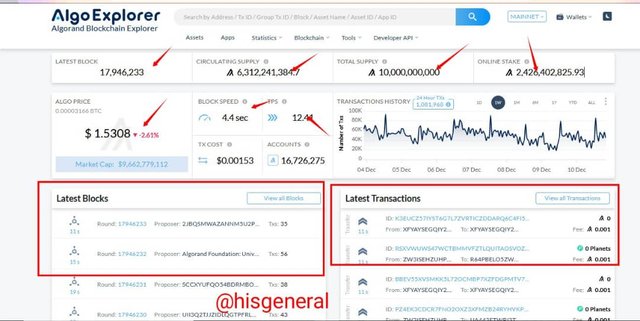
The following information is seen from the the landing page:
Lastest Block - 17,946,206
Circulating Supply - 6,312,241,384.7
Total Supply - 10,000,000,000
Online Stake - 2,426,402,825.93
ALGO price - $1.5318
Block Speed - 4.4sec
TPS - 12.41
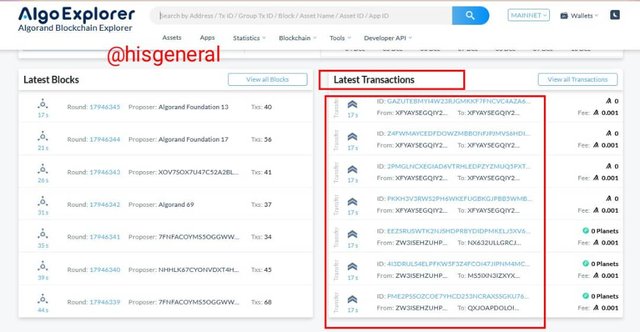
Click on any of the transaction IDs from the latest transaction to explore the Algo transaction (as indicated above)
The next interface displayed reveals the following details of the selected transaction ID.
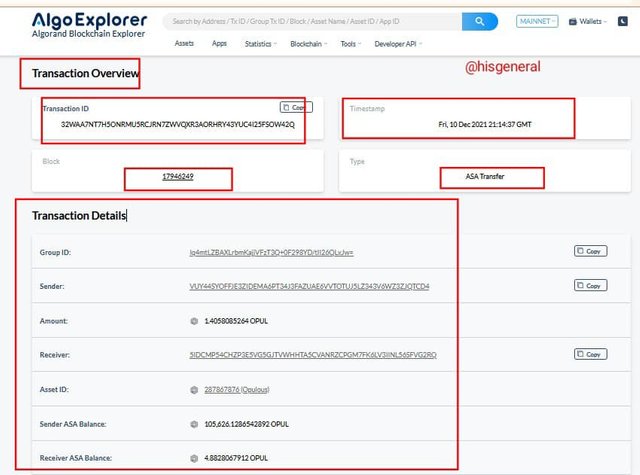
Transaction ID: 32WAA7NT7H5ONRMU5RCJRN7ZWVQXR3AORHRY43YUC4I25FSOW42Q
Timestamp: Fri, 10 Dec 2021 21:14:37 GMT
Block: 17946249
Type: ASA Transfer
Amount: 1.4058085264 OPUL
Receiver Copy: 5IDCMP54CHZP3E5VG5GJTVWHHTA5CVANRZCPGM7FK6LV3IINL56SFVG2RQ
Sender ASA Balance: 105,626.1286542892 OPUL
Receiver ASA Balance: 4.8828067912 OPUL

8. Carry out an analysis of the price of ALGO from the beginning of the year to the present. Via graphics (screenshots required.)

Firstly, we can observe the price of the ALGO token valued at $1.53 as at the time of this post. In view is the Market Cap and Circulating Supply which stands at $9,657,595,339 and circulating 6.31B ALGO respectively.
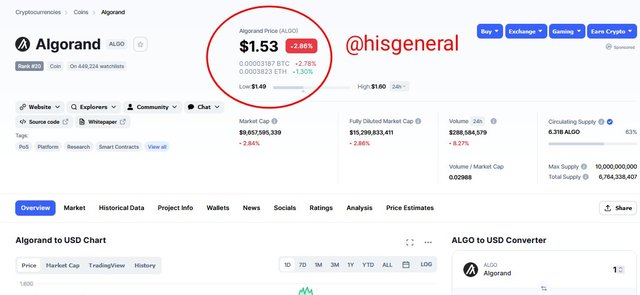
For the price analysis, we can see the graph indicating trends month by month for the ALGO token, and each month having it's high and low. Sometime in September 2021, we can observe that the price of the ALGO token got to its all time high for the period under review with value greater than $2 and Volume traded at $2B
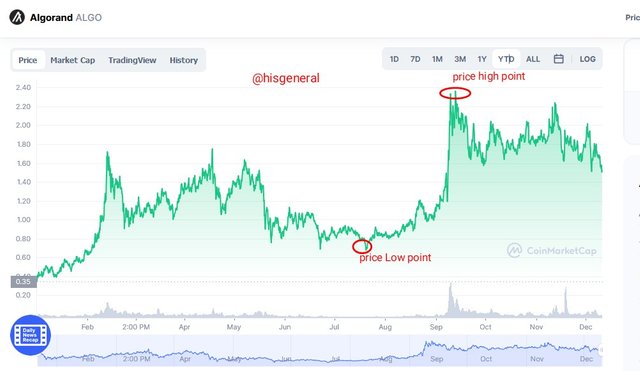
Also, looking at the chart analysis, we can also observe that price attained its lowest point in July 2021 where it was valued at $0.74 and volume traded at $62.96M.

9. Conclusion

The PPoS consensus mechanism is a deviation of PoS where new block validators are nominated through the VRF (Verifiable Random Function) unsystematically and with regards to the amount of tokens they staked. Furthermore, block leaders are randomly nominated which maintains the confidentiality of the validators' status until the confirmation of the transaction is verified to be accurate. This PPoS consensus mechanism is developed by the Algorand blockchain.
Based the VFR, A user who has $ALGO irrespective of the amount can be selected as a validator and there is no purnishment carried out on a user who proposes an erroneous block rather the system reverts to recovery mode enabling it to deflect attacks and crime as well as guarantee escalated speed.
Thank you professor @nane15 for such a lesson.
Note that all images used on this task are screenshots from algoexplorer site.
Cc:
@xkool24
